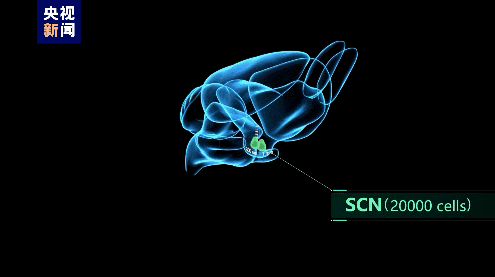
The antennae-like primary cilium works to regulate the biological clock. /China Media Group
The circadian clock, also known as the biological or body clock, has been identified as a visible internal clock after scientists discovered the signaling mechanism in brain neurons, according to a new study published in the academic journal Science on Friday.
Almost all mammals' physiological functions are ruled by the internal circadian rhythm to adapt to the rotation of day and night, and the coordination of physiology with daily rhythms is regulated by the neuron of the suprachiasmatic nucleus (SCN), the central pacemaker of the biological clock, said scientists from China's People's Liberation Army (PLA) Academy of Military Sciences.
In contrast to the traditional concept of an invisible biological clock, the scientists found a "tangible hand" of a biological clock in SCN neurons, which is called primary cilia.
Each neuron contains one primary cilium on the cell membrane, and the antenna-like cilium stretches every 24 hours, mediating Sonic Hedgehog (SHH) signaling that "allows cells in the master circadian clock to maintain synchronization and control circadian rhythmicity," said the study titled "Rhythmic cilia changes support SCN neuron coherence in circadian clock."
"The biological clock was previously thought to be an invisible clock, while this time we found that the antennae-like primary cilia sticking out of the cell surface show rhythmic changes, indicating that the biological clock is a tangible and visual internal clock," said Li Huiyan, researcher at the PLA Academy of Military Sciences and author of the study.
The researchers used mice for the experiment.
After being exposed to an altered light cycle to induce experimental jet lag, the mice with deficient cilia adapted to the new time cycle in one to two days, while the normal ones required seven to nine days.
"Disrupting SHH signaling allowed the animals to adjust more quickly to the altered environment," said the study.
Li said the mechanism can be used to regulate the body clock.
"When our rhythm gets out of whack, we can 'turn it off,' and as the outside environment gives us a new rhythm, our body can rapidly establish a new, stable and healthy rhythm that is completely in sync with the outside world," said Li.
A stable biological clock is essential to health, and an abnormal rhythm can lead to adverse consequences such as sleep disorders, metabolic disorders, immunity decline and serious diseases such as tumors, diabetes, and mental disorders.
The discovery "opens up a new path for the research and development of drugs for rhythm regulation, which makes it possible for our body to quickly cope with environmental perturbations and adapt to complex environments," said Li.


